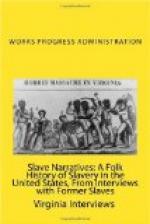“In cooking they had a round oven made like a pot only the bottom would be flat. It had an iron top. The oven was a bought oven. It was shaped like a barrel. The top lifted up. Coal was placed under the oven and a little on top.
Tables and Chairs
“Tables were just boards nailed together. Nothing but planks nailed together. I don’t remember nothing but homemade benches for chairs. They sometimes made platted or split-bottom chairs out of white oak. Strips of oak were seven feet long. They put them in water so they would bend easily and wove them while they were flexible and fresh. The whole chair bottom was made out of one strip just like in caning. Those chairs were stouter than the chairs they make now.”
(To be continued) [TR: No continuation found.]
Interviewer: Mrs. Annie L. LaCotts
Person interviewed: Matilda Miller
Humphrey,
Ark.
Age: 79
The day of the interview Matilda, a nice clean-looking Negro woman, was in bed, suffering from some kind of a pain in her head. She lives in a little two-room unpainted boxed house beside the highway in Humphrey. Her house is almost in the shadow of the big tank which was put up recently when the town acquired its water system.
When told that the visitor wanted to talk with her about her early life, Matilda said, “Well, honey, I’ll tell you all I can, but you see, I was just a little girl when the war was, but I’ve heard my mother tell lots of things about then.
“I was born a slave; my mother and daddy both were owned by Judge Richard Gamble at Crockett’s Bluff. I was born at Boone Hill—about twelve miles north of DeWitt—and how come it named Boone Hill, that farm was my young mistress’s. Her papa give it to her, just like he give me to her when I was little, and after she married Mr. Oliver Boone and lived there the farm always went by the name of ‘Boone Hill.’ The house is right on top of a hill, you know, it shure was a pretty place when Miss Georgia lived there, with great big Magnolia trees in the front yard. I belonged to Miss Georgia, my young mistress, and when the niggers were freed my mamma staid on with her. She was right there when both of his chillun were born, Mr. John Boone and Miss Mary, too. I nursed both of them chillun. You know who Miss Mary is now, don’t you? Yes’um, she’s Mr. Lester Black’s wife and he’s good, too.
“I was de oney child my mother had till twelve years after the surrender. You see, my papa went off with Yankees and didn’t come back till twelve years after we was free, and then I had some brothers and sisters. Exactly nine months from the day my daddy come home, I had a baby brother born. My mother said she knew my daddy had been married or took up with some other woman, but she hadn’t got a divorce and still counted him her husband. They lived for a long time with our white folks, for they were good to us, but you know after the boys and girls got grown and began to marry and live in different places, my parents wanted to be with them and left the white folks.




